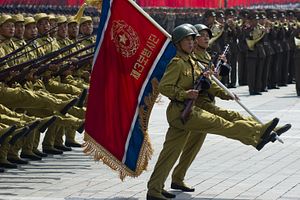North Korea has fielded two new helicopter-carrying frigates, according to commercial satellite imagery analyzed by 38 North.
38 North reported on Thursday that it has spotted two new helicopter carrying frigates from commercial satellite imagery. According to the report, the new frigates are the “largest surface combatants constructed by the DPRK’s Korean People’s Navy (KPN) in 25 years.”
The report said that construction on the two new vessels had begun in 2006-2007 and they had been launched in 2011 or 2012. It noted, however, that it was unclear if the helicopter frigates had yet been commissioned by the KPN, and also pointed out that “should the KPN push aggressively to commission and operate these new vessels, it will still likely take several years to fully integrate their new capabilities into fleet operations.”
The 38 North analysis, which was written by Joseph S. Bermudez Jr., the Chief Analytical Officer and Co-founder of AllSource Analysis, Inc., speculated that the new helicopter-carrying frigates had likely been built for anti-submarine warfare (ASW). Bermudez noted, for instance, that since the 1990s South Korea has acquired a number of submarines, which Pyongyang viewed as a security threat.
Bermudez also pointed out that the vessels might also be used to protect fisheries in the West and East Seas. In this latter scenario, they could present a challenge not just to South Korea but also to Japan and North Korea’s nominal ally, China.
Regarding the actual capabilities of the vessels, Bermudez writes: “Imagery indicates the two vessels are identical, measuring approximately 76 m x 11 m with an approximately 29 m x 11 m flight deck and armed with a suite of ASW weapons including rocket launchers and a helicopter as well as what may be a close-in weapons systems to defend against anti-ship missiles and small anti-aircraft missile mounts.”
He also suggests that the new frigates greatest potential weaknesses are likely to be in radar, sonar and electronic warfare capabilities and antiaircraft/antimissile defense because North Korea’s defense industry has historically struggled in these areas. However, the analysis points out that Pyongyang might be tempted to reach out to China or Iran for assistance in improving the vessels in these areas.
It comes as no surprise that North Korea is seeking to bolster its ASW capabilities. As I reported last year, South Korea has fielded a formidable undersea fleet. Already, the Republic of Korea Navy (ROKN) operates 13 submarines and Seoul has ambitious plans for its underwater future. This includes nine of the Chang Bogo class diesel-electric attack vessels that are the export versions of the German Type 209 class submarines.
Then, in 2000, it ordered three Type 214 (Son Won-Il class) diesel-electric submarines, which it commissioned between 2007 and 2009. The Type 214 subs are equipped with Air Independent Propulsion (AIP). In 2009, the ROKN ordered six additional Type 214s with significant improvements, including to its AIP systems. The first of these were commissioned last year.
Furthermore, the contracts for the Type 214 submarines came with technology transfer provisions that has allowed South Korea to begin eyeing a domestically produced submarine. In fact, Seoul intends to start building three 3,000-ton submarines beginning in 2018. They will be diesel-powered and are rumored to include vertical launch missile capabilities, which will dramatically improve ROKN’s long-range, underwater precision strike capabilities.
Thus, despite North Korea’s best efforts to counter South Korea’s growing underwater fleet, it still stands to be significantly outgunned in any future conflict. That’s assuming that it even learns how to operate the two new helicopter-carrying frigates it has built.
































